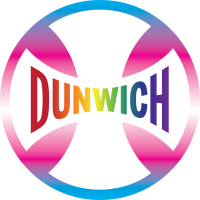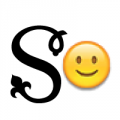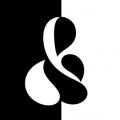Komik Ohne: A casual brush-pen blackletter

Christian Thalmann
Posts: 2,054
Here's something I've been doodling with my brush pens for a while now. I'm getting to the point where I like it enough to commit some type work to it to see where it might lead. I'm pretty bad at brush pens — especially at getting thin lines out of them —, so have mostly low-contrast strokes to work with. Still, between the subtle modulation within the strokes and some local lightening through loosely-joined strokes, the style is workable for blackletter.
The working title of this is currently Komik Ohne, a tongue-in-cheeck bad German translation of Comic Sans. I'm calling this the blackletter equivalent of Comic Sans, in the hopes of making a little PR out of the latter's pop culture status. «Use Komik Ohne for job applications, scientific presentations, monument inscriptions, etc. — basically, wherever you would use Comic Sans!» 
(I might switch to a more serious name later.)
First glyphs:

Whaddya think?
2
Comments
-
I like the style of the lowercase glyphs (maybe because their relation to blackletter is not as obvious). Some terminals are rather pointy and other more round (e.g. the upper left terminals of the /o are round, the lower right terminals are pointy). I would make the sharpness of the terminals more similar.The vertical line of the uppercase glyphs distract me a bit. It feels like the /K and the /O were crossed out.0
-
I know you're in the early stages, but it would help give a better feel for it if you had a few more letters/words. In terms of what you have thus far, I think the /o might be a little dark on the left.
0 -
I think this idea has the potential to be a good typeface. Keep at it.0
-
I like the style of the lowercase glyphs (maybe because their relation to blackletter is not as obvious).Well, ultimately, I do want it to be a blackletter typeface... good to know it might be marketable beyond that niche, though. I'll consider making a set of «tame» capitals for that purpose.Some terminals are rather pointy and other more round (e.g. the upper left terminals of the /o are round, the lower right terminals are pointy). I would make the sharpness of the terminals more similar.That's part of the natural variability of the brush pen as opposed to a broad-nib. I consider it a feature rather than a flaw. (We'll see if I still think that once we have enough material for running copy.)The vertical line of the uppercase glyphs distract me a bit. It feels like the /K and the /O were crossed out.
I wasn't going to use fine embellishments, originally, but tried it out and liked it so much that it stuck. I'm most likely going to make a series of caps without those (but retaining the full-weight interior architecture such as the splotches) for a stylistic set.
 0
0 -
Steve Gardner said:I know you're in the early stages, but it would help give a better feel for it if you had a few more letters/words. In terms of what you have thus far, I think the /o might be a little dark on the left.I know what you mean when looking at the /o up close... but texture-wise, it works well:
 In fact, when I try to lighten it, it starts to pop out to me. Maybe due to the lack of straight stems?0
In fact, when I try to lighten it, it starts to pop out to me. Maybe due to the lack of straight stems?0 -
Agreed, it's less noticeable in the second sample. I still do get a sense it's slighlty heavy top left, perhaps because of where you have the break, which gives more colour to the left of the /o than the right.
In any event, its good to see a little more of it and I definitely think it's worth developing further.
Something that stikes me about your second image (and this might be purely down to my viewing it on my mobile) is that words consisting of predominantly upright letters, such as /minimum, appear to lean slightly to the left. I don't see the same effect in /omino, even though both words contain /I, /m and /n.
Again, could be the size of my display playing tricks on my eyes, so it would be interesting to know if you see this too.0 -
Contrary to Linus, I quite like the vertical stroke in the K and O caps. I think they are better with them, and help create the echo of blackletter.
I really enjoy this typeface overall, and I think you are on to something. Round brush sans serif stencil blackletter....2 -
Looks nice.
 I would cut the endings of the strokes perpendiculary to their spines if I were you. It would give it a nice contrast of organic and mathematical forms, and would make it more similar to both stencil and fraktur. And would look especially nice in heavier weights. Just my 2 c.
I would cut the endings of the strokes perpendiculary to their spines if I were you. It would give it a nice contrast of organic and mathematical forms, and would make it more similar to both stencil and fraktur. And would look especially nice in heavier weights. Just my 2 c. 
Think of how animation characters are more interesting if they have both types of forms instead of one. E.g. the human leg has a straight front side and oval/curvy back. A bubbly leg like a baloon animal or one made only of straight lines like the Tin Wooodman looks less natural.0 -
Vasil: I can't see that working... I'm going for a natural brush look here; that would break the immersion.Going to bed now. Thinking of calling it «Kuschelfraktur» (cuddly fraktur) for publication.
 Status:
Status: 0
0 -
The stems themselves do lean forward a tiny bit so as to balance out the sinister trend of the on/offstrokes; maybe that's what you're seeing.Steve Gardner said:Something that stikes me about your second image (and this might be purely down to my viewing it on my mobile) is that words consisting of predominantly upright letters, such as /minimum, appear to lean slightly to the left. I don't see the same effect in /omino, even though both words contain /I, /m and /n.
0 -
I love it, but I think I love it because I get it. For type people, this is recognisably blackletter because of the broken textura construction, yadda yadda. But for non-type people, the characteristic features of a blackletter are that it’s thick, pointy and mëtäl, which this isn’t. So it may work as a typographic in-joke, but I am not sure that users will get it.3
-
Simon, I don't think that's a problem. The average layperson doesn't even recognize the difference between a serif font and a sans font. For them, it's just about whether or not they like it. I'm aiming for «like» here.

0 -
I think it is not even about whether they like it, but what their unconscious response to it is. This response is, generally, what a graphic designer is aiming for when using a certain typeface. Like, then, is too simple a response, and doesn't do justice to all the associations we instantly make when we see something.
In the case of your typeface, which I personally like, I fear the viewer might mostly be (unconsciously) confused, and thus doesn't associate it with very much at all. If I were you, I think I would make it a little more black-lettery, while retaining the brush feel. For example, you could increase the length and angle of the 'serifs'. Love the caps, btw.0 -
I agree. Select lowercase letters (the r in particular) and the uppercase letters (esp. with the "slashes") make sense only in a perception of the blackletter genre which isn't evoked by the other lowercase letters.
You could go more blacklettery with the latter (as Jasper is advising) or less with the former (thinking more abstractly about models--the strokeless cap variants, which I find intriguing move in that direction).0 -
I can see some reference to blackletter but in an odd way I'm seeing more of an asian influence, almost hindi/thai like. Weird? I dunno. I'd be curious to see how it would look if you simply added a headstroke above the letters like they do in hindi.0
-
I don't feel like making the lowercase stems more explicitly broken — that would firmly move it into familiar blackletter territory, and that has been done. (Also, it would move away from the concept of a blackletter sans.) I like exploring that parameter space between the traditional partitions of Antiqua and Blackletter.That said, my lowercase actually still looks very compatible with blackletter architecture to me. This is very explicit in letters like /d/g/h/k/r, but also visible in the shape of /o and /e, for instance. If this shows that Antiqua and Blackletter are less far apart from each other than we tend to think, all the better.
 That said, now that I have more material an can look at larger bodies of text, I do find that the slashed capitals are very unsubtle about their blackletter nature, and stand out among the sleek lowercase. I think I'm tending towards making the unslashed capitals the default after all, and offering the slashed ones as a decorative option (perhaps together with a few more Fraktur-specific shapes, such as the periscope /k?). I'd also be happy to include a set of more Antiqua-like capitals to allow for a motion in the opposite direction. Hopefully that would yield a perfectly matched Antiqua/Blackletter pair, for which I'm sure there are some nice uses...I figure I do have to tone down that /r in the default cut, though. I'm definitely keeping it for the Fraktur cut.0
That said, now that I have more material an can look at larger bodies of text, I do find that the slashed capitals are very unsubtle about their blackletter nature, and stand out among the sleek lowercase. I think I'm tending towards making the unslashed capitals the default after all, and offering the slashed ones as a decorative option (perhaps together with a few more Fraktur-specific shapes, such as the periscope /k?). I'd also be happy to include a set of more Antiqua-like capitals to allow for a motion in the opposite direction. Hopefully that would yield a perfectly matched Antiqua/Blackletter pair, for which I'm sure there are some nice uses...I figure I do have to tone down that /r in the default cut, though. I'm definitely keeping it for the Fraktur cut.0 -
Huh, I'm getting a bit of a CJK vibe from it.AbiRasheed said:I can see some reference to blackletter but in an odd way I'm seeing more of an asian influence, almost hindi/thai like. Weird? I dunno. I'd be curious to see how it would look if you simply added a headstroke above the letters like they do in hindi.
0 -
This is really great, Christian! I would definitely like to see you pursue this further. It has a really interesting character to it.Simon Cozens said:I love it, but I think I love it because I get it. For type people, this is recognisably blackletter because of the broken textura construction, yadda yadda. But for non-type people, the characteristic features of a blackletter are that it’s thick, pointy and mëtäl, which this isn’t. So it may work as a typographic in-joke, but I am not sure that users will get it.
I also want to chime in to share why I disagree with Simon. While I understand where you’re coming from Simon, I don’t believe aesthetics are inherently linked to “getting it” or having a deep understanding of typographic styles. It seems entirely limiting and nonconstructive to suggest that “thick, pointy and mëtäl” are the only successful or defining characteristics of blackletter to “non-type people.” And I say this because inventive takes on the style (like this one) are squandered when we simply adhere/conform to expectations or generalized ideals.
As a graphic designer, as someone who works with a well-respected designer, and as someone with many friends in the field, I must say that “liking something” and making purely aesthetic-based/intuitive decisions is not only a valid approach but also the primary means in which we work. But I do suspect that you’re pedantically caught on the term “like” because I’d suggest that our “unconscious response” is often whether or not we like it.Jasper de Waard said:I think it is not even about whether they like it, but what their unconscious response to it is. This response is, generally, what a graphic designer is aiming for when using a certain typeface. Like, then, is too simple a response, and doesn't do justice to all the associations we instantly make when we see something.
In the case of your typeface, which I personally like, I fear the viewer might mostly be (unconsciously) confused, and thus doesn't associate it with very much at all. If I were you, I think I would make it a little more black-lettery, while retaining the brush feel. For example, you could increase the length and angle of the 'serifs'. Love the caps, btw.
When I’m looking at type, whether by myself or with Louise (Fili), we aren’t seeking to answer “Do we understand this? Do we get it’s origins?” Instead, we’re trying to answer “Is this interesting? Does this fit our project? Does it contribute to it’s aesthetic message?”
With that being said. This is interesting, and it seems that everyone else agrees. Whether or not it needs to become more blackletter-like to become less of a “typographic in-joke” or to ensure people get it, I don’t think needs to be a primary concern. I’m more interested in seeing you continue to push this further. This has a very causal feel, and making it any more angular I fear will take-away from your intentions and your voice.
In terms of actual critique or comments, I’d like to see the breaks in the letterforms become more consistent. The top left of the e, s, and k for example are quite tight in comparison to the m, n, and o. I also really like the idea of including the simple alternate caps.
One last thing, if you were to explore a heavier weight, I’d love it if the gaps started to close/bleed together as opposed to preserving the separation. (But still make it evident that there are breaks in the strokes.)3 -
Thanks Matthew, I feel understood.
 Good point about homogenizing the gap size. Yeah, I do intend to approach the Bold that way, otherwise the strokes would probably become too chubby.Meanwhile: I don't suppose I can get away with that Fraktur-style /y in the regular cut... can I keep the slashed /x, though...?
Good point about homogenizing the gap size. Yeah, I do intend to approach the Bold that way, otherwise the strokes would probably become too chubby.Meanwhile: I don't suppose I can get away with that Fraktur-style /y in the regular cut... can I keep the slashed /x, though...?

0 -
The last few lowercase letters were the hardest for some reason!I've also made a stylistic set for the weirder forms of traditional Fraktur that I don't want to offer in the default cut. Do they work? That /x is monstrous, but it's supposed to be...

0 -
Coming along nicely. I was a bit scared of what you’d do with the /w/ but I like this one!
Stem of /f/ (and long /s/) look stiffer than everything else. Tittles may be a touch too casual.
Should /ß/ have one more stencil break like /z/?
Although the two-story /a/ is handsome on its own, it may be that that the one-story version would be a more fitting default.
I don’t really see the usefulness of the alts, but anyway that /k/ seems relatively dark and dense, like it wants more stencil breaks.0 -
Craig Eliason said:Coming along nicely. I was a bit scared of what you’d do with the /w/ but I like this one!Hehe, I deserve that.
 Stem of /f/ (and long /s/) look stiffer than everything else. Tittles may be a touch too casual.Gave the stems a bit more swing. Kept the tittles; a bit of tilt is necessary for a blackletter IMHO.Should /ß/ have one more stencil break like /z/?Thought of that, and of /k/ as well, but those partial shapes fall apart a bit with an extra gap. The /z/ also looks better without the gap, but I gave it one so as better to fit in.Although the two-story /a/ is handsome on its own, it may be that that the one-story version would be a more fitting default.It's a bit bland in comparison. I'll definitely put it into a stylistic set of its own, though, rather than bundle it with the fraktur alts.I don’t really see the usefulness of the alts, but anyway that /k/ seems relatively dark and dense, like it wants more stencil breaks.The people over on the German forum certainly seem to appreciate them.
Stem of /f/ (and long /s/) look stiffer than everything else. Tittles may be a touch too casual.Gave the stems a bit more swing. Kept the tittles; a bit of tilt is necessary for a blackletter IMHO.Should /ß/ have one more stencil break like /z/?Thought of that, and of /k/ as well, but those partial shapes fall apart a bit with an extra gap. The /z/ also looks better without the gap, but I gave it one so as better to fit in.Although the two-story /a/ is handsome on its own, it may be that that the one-story version would be a more fitting default.It's a bit bland in comparison. I'll definitely put it into a stylistic set of its own, though, rather than bundle it with the fraktur alts.I don’t really see the usefulness of the alts, but anyway that /k/ seems relatively dark and dense, like it wants more stencil breaks.The people over on the German forum certainly seem to appreciate them. I think the morningstar /k/ is supposed to be clumpy on top; it's how it sets itself apart from /t/. One more break did help, though:
I think the morningstar /k/ is supposed to be clumpy on top; it's how it sets itself apart from /t/. One more break did help, though:
0 -
Or rather:

0 -
Started on the capitals:
 I'm quite happy about that /G/!
I'm quite happy about that /G/!
0 -
Latest version, after feedback from actual fraktur readers...

1 -
Some more caps:
 0
0 -
The /C and /T without strokes might read as /E.I dig that /S!0
-
I'm thinking of removing the floating dots in the unslashed versions of /C, /G, /T etc. and accepting the ensuing white space, even if that's antithetical to blackletter... (Actually, I just tried that; I don't like it.)Yeah, I like the /S too. It's intended to follow the overall structure of the fraktur /S but also imply the connectedness of the Roman S.0
-
First complete set of capitals.That /X was a pain, but I like the way it came out.

0 -
Given how these caps are significantly more ornate than the lowercase (not unusual for blackletter), I wonder whether it wouldn't be worthwhile to add a series of plainer caps as well. Quite a different overall feel with otherwise the same typeface chassis:
 I also plan to make a few alternates for the harder-to-read blackletter caps, but that would have to be separate from the plain caps series.
I also plan to make a few alternates for the harder-to-read blackletter caps, but that would have to be separate from the plain caps series.
0
Categories
- All Categories
- 46 Introductions
- 3.9K Typeface Design
- 487 Type Design Critiques
- 564 Type Design Software
- 1.1K Type Design Technique & Theory
- 656 Type Business
- 861 Font Technology
- 29 Punchcutting
- 520 Typography
- 119 Type Education
- 324 Type History
- 77 Type Resources
- 112 Lettering and Calligraphy
- 33 Lettering Critiques
- 79 Lettering Technique & Theory
- 558 Announcements
- 94 Events
- 114 Job Postings
- 170 Type Releases
- 179 Miscellaneous News
- 276 About TypeDrawers
- 54 TypeDrawers Announcements
- 120 Suggestions and Bug Reports








